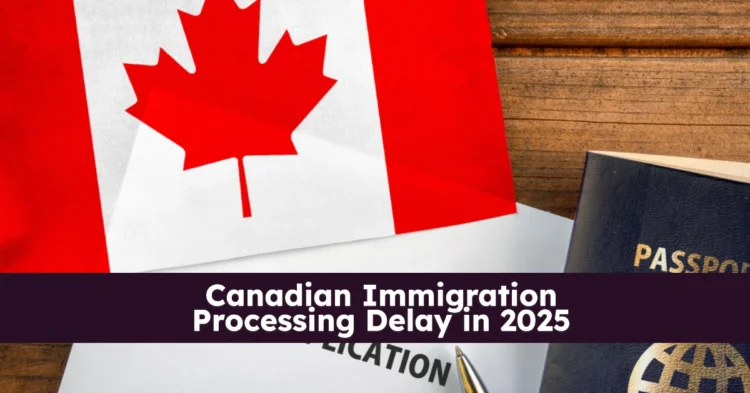Canada’s immigration system is at a tipping point. In 2025, nearly 3 million temporary residents are stuck in limbo as Canadian immigration processing delays hit record levels. From international students and temporary workers to spouses of Canadian citizens, delays in work permits, study permit extensions, and spousal sponsorships are upending lives across the country.
Table of Contents
This report dives deep into the backlog crisis facing Immigration, Refugees and Citizenship Canada (IRCC), the Labour Market Impact Assessment (LMIA) bottlenecks at Employment and Social Development Canada (ESDC), and the human consequences of a system under immense strain.
The Immigration Backlog: A System Under Siege
As of March 31, 2025, IRCC is managing 1.97 million applications across temporary, permanent, and citizenship categories. While slightly down from February’s 2.03 million, this number still reflects a massive immigration backlog that shows little sign of easing.
The most pressing Canadian immigration processing delays include:
- Work permit extensions: 237 days
- Study permit extensions: 234 days
- Visitor visa extensions: 169 days
- Spousal sponsorship (Outside Quebec): 29 months
- Spousal sponsorship (Quebec): 36 months
These delays are well beyond IRCC’s published service standards and are affecting every corner of the immigration system.
Temporary Residents: Stuck in Status Limbo
Canada currently hosts 3,020,936 non-permanent residents—a figure that declined in Q1 2025 for the first time in years. Many of these individuals are now experiencing the harsh reality of the Canadian immigration processing delay crisis:
- International students waiting over 7 months for study permit extensions risk losing their legal status and academic continuity.
- Temporary foreign workers essential to sectors like agriculture and healthcare are enduring delays that threaten jobs and income.
- Visitors, including family members hoping to stay longer in Canada, are unable to plan with delays stretching over five months.
The uncertainty is not just a bureaucratic issue—it’s a quality-of-life emergency.
LMIA Delays: Choking the Labour Pipeline
The Labour Market Impact Assessment (LMIA) is a prerequisite for many foreign workers to apply for a Canadian work permit. In 2025, delays are widespread:
- High- and low-wage LMIAs: 61 business days
- Permanent Residence LMIAs: 214 business days
- Global Talent Stream: 8 business days (still functioning efficiently)
These delays come before the 237-day average work permit wait, meaning some foreign workers could wait over a year to begin employment.
“This mismatch is forcing some workers to leave Canada,” notes RCIC Kamal Deep Singh, “and reflects a wider strategy to reduce the temporary resident population.”
A Quiet Push for Temporary Residents to Leave?
The federal government’s 2025–2027 Immigration Levels Plan calls for 395,000 new permanent residents in 2025, prioritizing economic and provincial nominee programs. But simultaneous caps on study permits and a pause on Express Entry draws suggest a policy pivot away from temporary residents.
Immigration experts are increasingly convinced that prolonged Canadian immigration processing delays are not just coincidental—they may be a strategic tool to quietly encourage voluntary departures.
Spousal Sponsorship: Families Waiting Years to Reunite
Among the most heart-wrenching consequences of the 2025 Canadian immigration processing delay is the collapse of spousal sponsorship timelines:
- Outside Quebec: 29 months
- Quebec: 36 months
Families are living in separation, facing emotional and financial strain. One Cape Breton man, after his spouse’s visa was denied, told CTV News: “All I want is to start a family.”
The delays contradict Canada’s long-standing commitment to family reunification and raise serious questions about its immigration priorities.
What Is a Temporary Resident in Canada?
According to IRCC, temporary residents include:
- International students
- Temporary foreign workers
- Visitors and tourists
- Asylum claimants
- Temporary Resident Permit (TRP) holders
These individuals play a vital role in Canada’s workforce and economy—particularly in healthcare, construction, tech, and education—yet many now face unprecedented uncertainty.
Key Stats (May 2025):
| Application Type | Avg. Wait Time |
|---|---|
| Work Permit Extension | 237 days |
| Study Permit Extension | 234 days |
| Visitor Visa Extension | 169 days |
| Spousal Sponsorship (Non-Quebec) | 29 months |
| LMIA (PR Stream) | 214 business days |
Conclusion
The Canadian immigration processing delay crisis is not just about numbers—it’s about real people with dreams, families, and futures on hold.
The combination of:
- 3,300 IRCC job cuts,
- backlogged LMIA assessments, and
- an apparent strategy to thin out temporary residents
has created what immigration experts are calling a “perfect storm.”
To restore confidence, protect economic growth, and live up to its humanitarian ideals, Canada must act swiftly to address these delays before its immigration system loses credibility at home and abroad.

